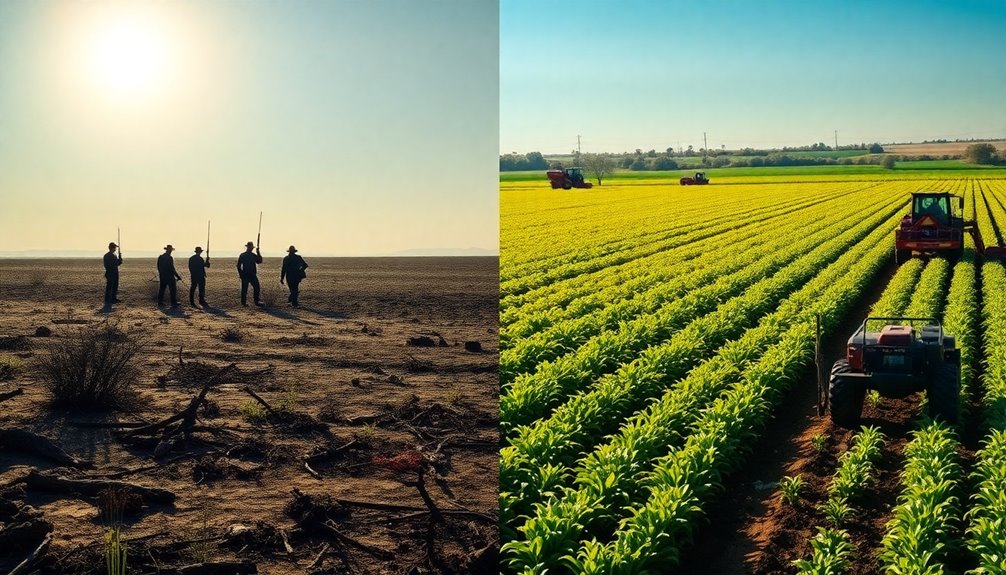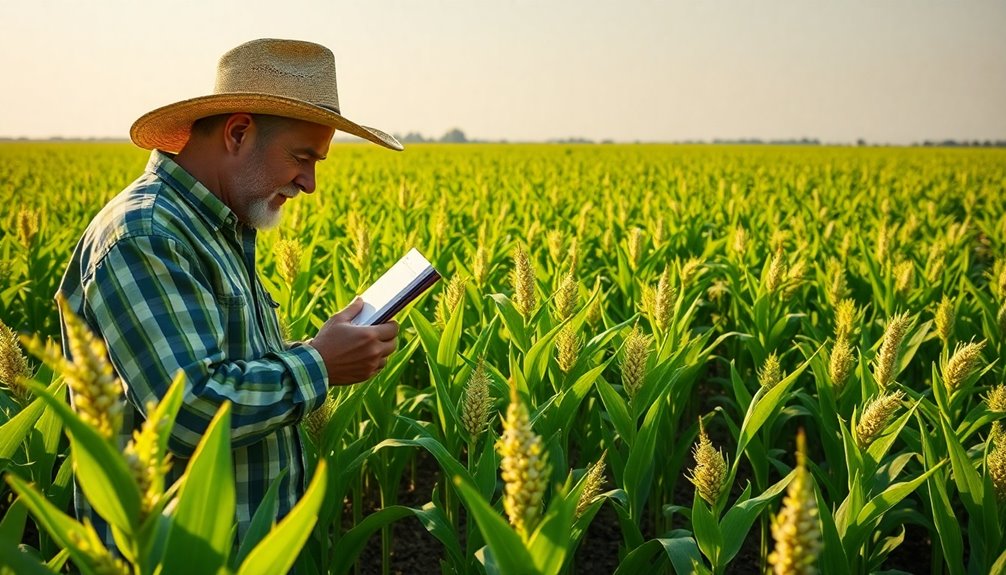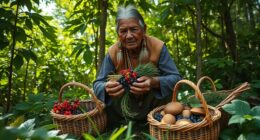Hunting and foraging might seem appealing, but they have real disadvantages compared to agriculture. You'll find that these lifestyles are often less reliable for food supply, making you vulnerable to scarcity and seasonal changes. While they promote healthier diets with diverse nutrition, the lack of food storage limits sustenance. Social structures can also be fragile, with smaller communities facing challenges. Plus, the workload is different; foragers may enjoy leisure time, but your chances of instability rise. If you want to explore the deeper implications of these lifestyles, keep looking for more insights on how they compare.
Key Takeaways
- Hunting and foraging rely on unpredictable food sources, leading to potential scarcity and limited food availability compared to agriculture's systematic production.
- Agricultural societies can support larger populations, whereas hunting and foraging limit community size and can lead to vulnerability during resource shortages.
- The mobility required for hunting and foraging prevents permanent settlements, restricting the development of complex social structures seen in agricultural societies.
- Agricultural practices allow for food storage and surplus, whereas hunter-gatherers have limited food preservation capabilities, increasing their risk during lean seasons.
- While agriculture creates social hierarchies and inequalities, hunting and foraging promote egalitarian structures, which can be undermined by resource competition.
Overview of Hunting and Foraging

Hunting and foraging represent ancient lifestyles that rely on the active pursuit of food through hunting animals and gathering plants. In hunter-gatherer societies, you'll find a diverse diet that supports better nutrition and health compared to early agricultural diets. The need to follow animal migrations and seasonal plant availability fosters greater mobility, allowing these groups to adapt effectively to environmental changes. This adaptability can be linked to the concept of zone of proximal development, as children learn to navigate their environment through exploration and interaction with their surroundings.
Smaller community sizes enhance social cohesion and cooperation, promoting strong interpersonal relationships among members.
However, despite these advantages, hunter-gatherers face significant vulnerabilities. Food scarcity can hit hard during harsh conditions, and their limited food storage capabilities make long-term planning a challenge. This unpredictability can lead to periods of hunger and uncertainty, impacting their overall stability. While their nutritional quality often surpasses that of early agricultural societies, the reliance on immediate resources can expose them to risks that more sedentary lifestyles might mitigate. Ultimately, while hunting and foraging offer a fulfilling and diverse food source, they also present challenges that underscore the delicate balance these societies maintain with their environment. Additionally, the lack of consistent food sources can make it difficult to achieve long-term savings in terms of food security and resource management.
Overview of Agriculture

Agriculture marks a significant shift in human practices, focusing on the systematic preparation of land for cultivating crops and raising livestock. This change allowed for increased food production compared to the hunter-gatherer society, enabling larger populations and permanent settlements.
However, agriculture comes with its own set of advantages and disadvantages.
- Increased Food Production: You can grow more food than you could gather, supporting larger communities.
- Permanent Settlements: With agriculture, people establish homes, leading to more complex social structures.
- Social Inequalities: Control over food surplus can create class distinctions and exploitation.
While agriculture has certainly transformed human society, it also poses risks. Many agricultural practices depend on a limited number of crop varieties, increasing vulnerability to malnutrition and famine if those crops fail.
Additionally, reliance on monoculture can lead to environmental issues like soil depletion and reduced biodiversity. Furthermore, the shift to agriculture can challenge community dynamics and emotional alignment as societies become more complex and hierarchical.
As you explore the advantages and disadvantages of agriculture, keep in mind that its developments have shaped not just how we produce food, but also how societies function and interact with the environment.
Nutritional Impacts
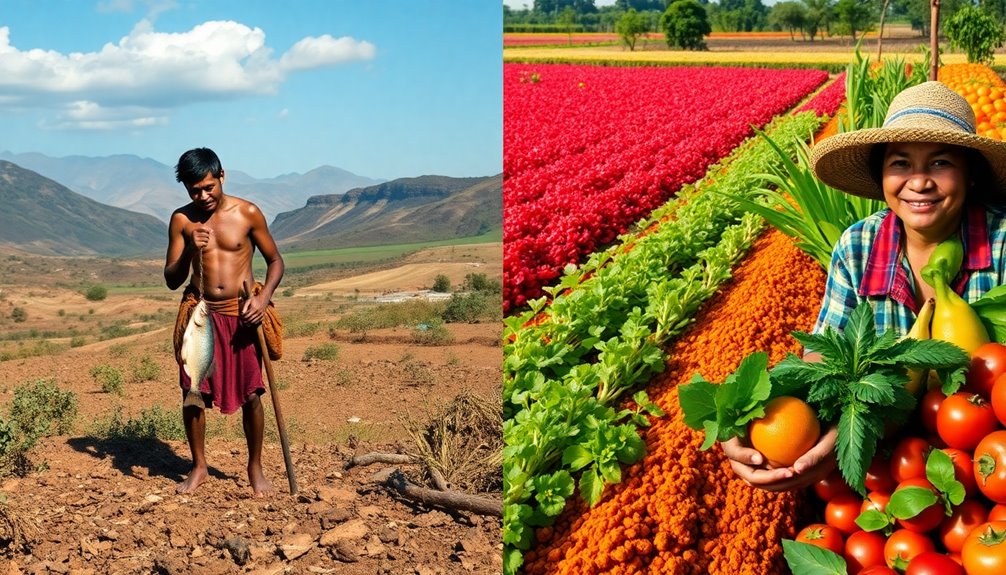
When you compare the nutritional diversity of hunter-gatherer diets to those of agricultural societies, the differences become clear.
Hunter-gatherers enjoy a wide array of foods that promote better health outcomes, while agricultural diets often lead to deficiencies and health issues.
Understanding these impacts can shed light on the long-term consequences of our food choices.
Nutritional Diversity Comparison
In comparing nutritional diversity, hunter-gatherers clearly had the upper hand over early agricultural societies. Their diets consisted of a wide array of wild plants and animals, providing essential nutrients that were often missing in the more restricted agricultural diets. This variety considerably reduced the risk of malnutrition-related diseases and contributed to overall better health.
Consider these key differences:
- Food Sources: Hunter-gatherers accessed around 200 different food sources, ensuring a rich variety of nutrients.
- Nutritional Deficiencies: Agricultural societies often relied on a few staple crops, leading to deficiencies in essential vitamins and minerals.
- Chronic Diseases: Hunter-gatherers showed lower rates of chronic diseases, such as diabetes and heart issues, compared to the health problems linked with the diets of early farmers.
The skeletal remains of hunter-gatherers reveal no signs of modern diseases, while early agricultural societies faced dental and bone health issues. Additionally, the importance of a proper diet in maintaining overall health is evident from the varied food sources hunter-gatherers consumed.
This stark contrast highlights the importance of nutritional diversity in maintaining health and reducing vulnerability to diseases. Ultimately, the varied diets of hunter-gatherers provided a considerable advantage over the limited options found in agricultural societies.
Health Risks of Agriculture
Shifting from a hunter-gatherer lifestyle to agriculture introduced several health risks tied to nutritional impacts. Early agricultural diets often lacked the diversity that hunter-gatherers enjoyed, leading to significant nutritional deficiencies. While hunter-gatherers had access to a wide range of plants and animals, agricultural societies became dependent on staple crops, making them more vulnerable to famine and malnutrition.
Studies show that communities engaging in agriculture experienced higher rates of health deficiencies. Archaeological evidence reveals that skeletal remains of early farmers frequently displayed signs of poorer health, such as dental issues and weaker bones, compared to those of hunter-gatherers.
Particularly, research by Jared Diamond highlights that the caloric intake of hunter-gatherers, like the Bushmen, resulted in better nutrition than that of early farmers.
Moreover, the close proximity to domesticated animals in agricultural societies heightened exposure to zoonotic diseases. This increased risk contributed to health issues such as malaria and smallpox, which were less prevalent among hunter-gatherers.
Additionally, foraging for wild edibles like wild leeks and blueberries can provide a nutrient-rich alternative that enhances dietary diversity.
Ultimately, the shift to agriculture brought about serious health risks that affected the nutritional well-being of early farming communities.
Social Structure and Inequality

Hunter-gatherer societies naturally foster egalitarian structures with minimal social hierarchies, unlike agricultural communities that often see pronounced class distinctions.
As agriculture developed, it brought about significant changes in social dynamics, leading to increased gender inequality and wealth accumulation among a select few. This shift resulted in:
- Pronounced Social Hierarchies: In agricultural societies, structured roles emerged, creating a clear divide between the wealthy elite and the working class.
- Increased Gender Inequality: Men typically assumed superior roles, while hunter-gatherer groups maintained more flexible gender roles, with both sexes participating equally in sustenance.
- Resource Competition: Agricultural practices led to competition for resources, heightening social conflict and straining community ties, contrasting sharply with the cooperative dynamics of hunter-gatherer societies.
While hunter-gatherers may have had fewer possessions, they weren't considered poor, reflecting a different understanding of wealth and social status.
The change to agriculture not only established disparities but also set the stage for inequalities that persist today, echoing the social divisions first seen in early agricultural communities.
Leisure Time and Lifestyle

When you compare hunter-gatherers to agricultural societies, you'll notice a stark difference in work-life balance.
While hunter-gatherers enjoyed ample leisure time for cultural activities and hobbies, farmers often found themselves overwhelmed by the constant demands of crop and livestock management.
This shift not only limited personal pursuits but also increased stress levels, impacting overall quality of life.
Work-Life Balance Differences
In societies that relied on hunting and foraging, people enjoyed a remarkable balance between work and leisure, spending only 12-19 hours a week on food acquisition. This lifestyle allowed for ample leisure time, fostering community well-being and reducing stress levels.
In stark contrast, agricultural societies demanded longer hours for crop maintenance and livestock care, which considerably cut into personal leisure time.
Consider these differences:
- Work Hours: Hunter-gatherers worked fewer hours, promoting a healthier work-life balance.
- Leisure Activities: More free time allowed for cultural and technological development in hunter-gatherer societies.
- Stress Levels: The relaxed lifestyle of hunter-gatherers led to lower stress levels compared to the labor-intensive agricultural life.
Critics argue that the demands of farming and resource management outweighed the benefits, leading to a decline in overall quality of life.
The shift to agriculture not only increased workload but also diminished the quality of leisure time, illustrating how work-life balance can dramatically affect your lifestyle.
Ultimately, while agriculture advanced society in many ways, it came at the cost of that precious leisure time enjoyed by hunter-gatherers.
Cultural Activities and Hobbies
Amid the abundance of free time enjoyed by hunter-gatherer societies, cultural activities and hobbies flourished, enriching their lives in ways that agricultural lifestyles often couldn't match. With only 12-19 hours per week dedicated to food procurement, they embraced leisure time for arts, storytelling, and communal gatherings, fostering community well-being and enhancing quality of life. This emphasis on curiosity and happiness allowed individuals to explore new ideas and engage deeply with their surroundings.
Here's a comparison of the cultural engagement in hunter-gatherer versus agricultural lifestyles:
| Feature | Hunter-Gatherer Societies | Agricultural Lifestyles |
|---|---|---|
| Leisure Time | Ample | Limited |
| Cultural Activities | Flourished | Restricted |
| Community Well-being | Strong | Weakened |
In hunter-gatherer communities, the balance of work and leisure nurtured creativity and social bonds. In contrast, agricultural lifestyles often led to increased workloads and stress, diminishing opportunities for personal pursuits. As a result, the rich tapestry of cultural activities seen in hunter-gatherer societies is often lost in the push for productivity associated with agriculture. Ultimately, this shift affects not just individual fulfillment but the overall quality of life within these communities.
Impact on Stress Levels
The shift from a hunter-gatherer lifestyle to agriculture markedly impacts stress levels among individuals. Hunter-gatherers typically spent only 12-19 hours per week obtaining food, which allowed for significant leisure time. This balance not only enhanced the quality of life but also fostered better mental health within communities.
In contrast, agricultural societies require longer working hours for farming, leading to increased stress levels. Here are three key differences:
- Leisure Time: Hunter-gatherers enjoyed ample free time, engaging in cultural and social activities that strengthened community bonds.
- Workload: In agricultural settings, the demands of farming and livestock care result in longer hours, leaving little room for relaxation or creativity.
- Community Cohesion: The relaxed lifestyle of hunter-gatherers nurtured a sense of belonging, while the pressures of agricultural life often lead to anxiety and isolation.
Ultimately, the conversion to agriculture not only escalates daily workloads but also diminishes overall quality of life.
Technological Advancements
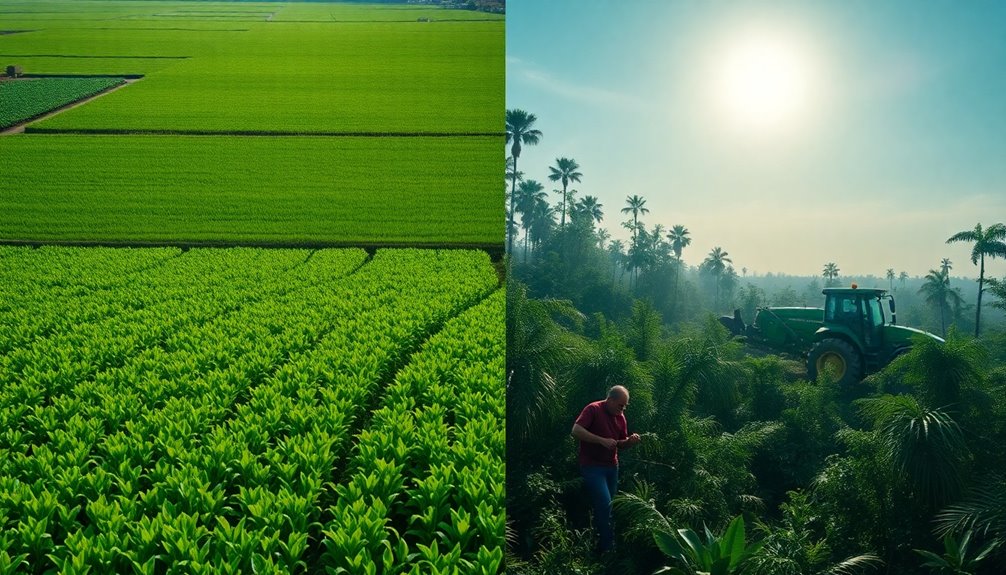
Technological advancements flourished with the shift from hunting and foraging to agriculture, transforming how societies operated. As you explore agricultural societies, you'll notice that the development of permanent settlements led to larger populations and specialized labor. This specialization spurred various technological innovations, including irrigation systems and advanced farming tools.
With a surplus of food, these societies could support more complex structures, enabling further progress in art, writing, and trade. However, this reliance on agriculture also created vulnerabilities. For instance, monoculture practices made societies susceptible to food shortages and societal collapse, a stark reminder seen in historical events like the Irish Potato Famine.
Moreover, while these technological innovations enhanced productivity, they often came at a cost. The rise of hierarchies and inequalities overshadowed the cooperative dynamics of hunter-gatherer groups, leading to questions about social stability.
You might find it intriguing that the same advancements which propelled societies forward also introduced challenges that disrupted communal harmony. In evaluating the balance between progress and stability, it's essential to recognize the dual-edged nature of these technological advancements within agricultural frameworks.
Long-term Consequences and Modern Implications
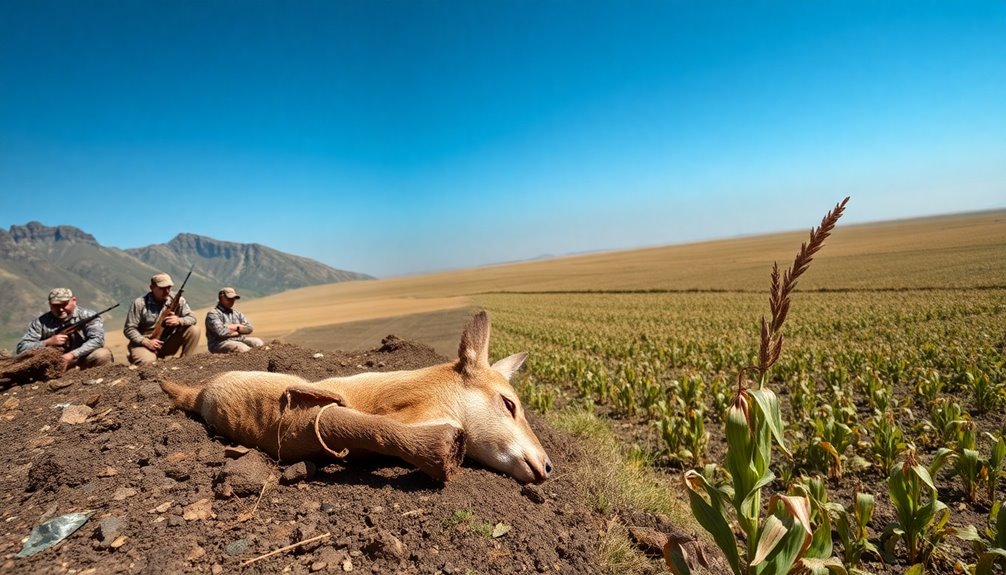
Agricultural advancements set the stage for profound long-term consequences that shape our modern world. While agriculture fueled the growth of complex societies, it also sowed the seeds of social inequality and vulnerability to food shortages, issues that echo today.
Consider these key implications:
- Social Inequality: The rise of agricultural societies created class divisions that persist in contemporary society, leading to disparities in wealth and access to resources. Additionally, the emergence of tea-related merchandise reflects how societal stratification can influence consumer behavior and preferences. Furthermore, the astrological influences on charismatic leadership can also reinforce these class divisions by shaping societal perceptions.
- Food Shortages: Historical evidence, like the Irish Potato Famine, illustrates how reliance on monocultures can result in devastating food shortages, a risk that remains relevant as we face global population growth.
- Environmental Degradation: Agriculture's expansion has led to significant environmental issues, threatening biodiversity and long-term food security, especially as we approach a projected 9 billion people by 2050. Additionally, the shift from traditional practices to intensive farming methods has increased reliance on fossil fuels, contributing to a higher carbon footprint and exacerbating climate change.
Despite the technological advancements agriculture has enabled, the societal issues it introduced—like health concerns and social stratification—continue to prompt debates.
Understanding these long-term consequences is essential as we navigate contemporary issues stemming from our agricultural past.
Frequently Asked Questions
What Are the Disadvantages of Hunting and Foraging vs. Agriculture?
Hunting and foraging can limit your food security and community growth. You might face food scarcity during tough times and struggle with a less stable diet, as wild resources can vary seasonally.
The nomadic lifestyle makes establishing permanent settlements difficult, and you could be vulnerable to conflicts with larger groups.
Additionally, the lack of technology in hunting and foraging can hinder your society's advancement compared to the innovations that come from agricultural practices.
What Are the Disadvantages of Foraging Behavior?
Did you know that hunter-gatherer societies can face infant mortality rates of up to 50%?
When you rely solely on foraging, you encounter significant disadvantages. Food availability can be unpredictable, leading to periods of scarcity, especially during harsh conditions.
You also lack the ability to store food long-term, making you vulnerable to sudden resource changes.
Additionally, smaller group sizes limit social and economic opportunities, reducing potential for trade and collaboration.
What Are Some Disadvantages of Hunting and Gathering?
Hunting and gathering can be tough due to food scarcity, especially during harsh weather.
You've got limited ability to store food, which can lead to hunger.
Plus, high infant mortality rates often mean shorter life expectancy for your community.
With no permanent homes, accessing medical care is tricky, impacting health.
Social isolation might arise when you interact with neighboring groups, and smaller populations can leave you vulnerable to larger, more organized societies.
What Was One Disadvantage of Hunting for Food?
Imagine relying on takeout for dinner every night—it's convenient, but what if your favorite spot runs out of food?
That's similar to hunting for food. You face an unpredictable supply, making it tough to guarantee consistent nutrition. When game's scarce, you might experience periods of hunger.
Plus, you depend on wild animal populations, which can be dangerously depleted, leaving you vulnerable and struggling to feed your group during lean times.
Conclusion
In the end, while hunting and foraging connect you to nature, they come with notable disadvantages compared to agriculture. As the saying goes, "You can't have your cake and eat it too." The nutritional impacts, social inequalities, and limited leisure time can make the hunter-gatherer lifestyle challenging. Embracing agriculture has paved the way for technological advancements and more stable societies, but it is crucial to remember the balance between progress and the wisdom of our ancestors.

